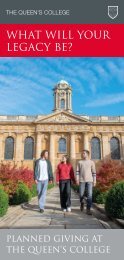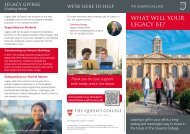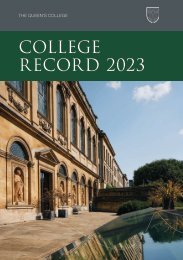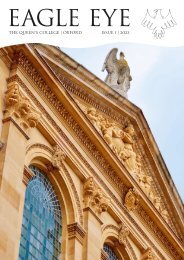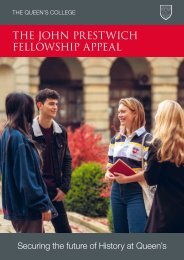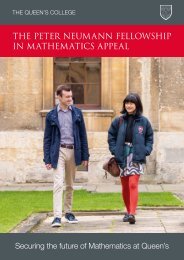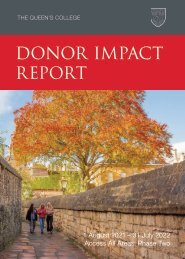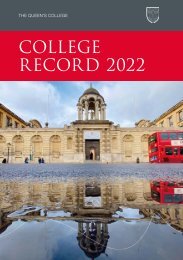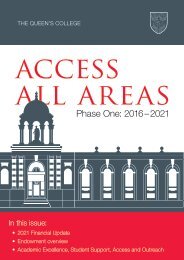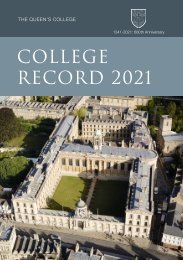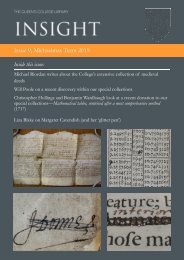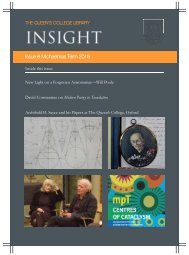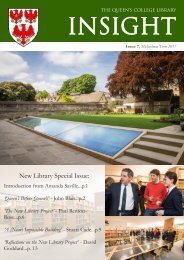The Queen's College Record 2020
You also want an ePaper? Increase the reach of your titles
YUMPU automatically turns print PDFs into web optimized ePapers that Google loves.
Obituaries<br />
and George Hasell (Queen’s, 1867) who provided financial support for Bill’s schooling.<br />
Attending St Bees School from 1926, he came up to Queen’s in 1930, receiving a<br />
Thomas Exhibition. On arrival he noted that the Provost had not been seen for over<br />
ten years, but the <strong>College</strong> did brew its own beer. Taught by such luminaries as Charles<br />
Sherrington and John Eccles, Bill also listened to Gandhi speaking at a small public<br />
meeting in the town.<br />
Graduating BA in 1934, Bill moved to St Mary’s Hospital for clinical training. Here his<br />
teachers included Sir Almroth Wright, Alexander Fleming (who warned students of the<br />
likely development of antibiotic resistance) and Leonard Colebrook (who demonstrated<br />
the life-saving effects of ‘Prontosil rubrum’ in puerperal sepsis). An accomplished<br />
middle-distance runner, Bill always found it amusing that he returned to Iffley Road to<br />
‘compete for a University (London) of which I am not a member, against my own.’<br />
Qualifying BM, BCh in 1938, Bill’s first appointment was House Physician to Sir<br />
Charles Wilson (later Lord Moran). <strong>The</strong> winds of war were blowing through Europe<br />
and on 1 September 1939 Bill volunteered for the Royal Army Medical Corps, aware<br />
that there would be a great demand for doctors. After two years of service at home,<br />
he sailed from Liverpool in September 1941, destination unknown. His ship berthed<br />
in Singapore one week before the tumultuous events of Pearl Harbor. Over the next<br />
three months he witnessed the Japanese attacks, and only avoided being bayonetted<br />
to death by ‘the toss of coin.’ Just two days before capitulation he ensured the safe<br />
passage of 35 nurses to Singapore Harbour where they boarded a ship requisitioned<br />
for evacuation.<br />
Taken prisoner on 15 February 1942, Bill spent the next 18 months in Changi Camp<br />
where he witnessed the effects of starvation, deprivation and wanton cruelty on his<br />
fellow prisoners, whilst at the same time practising medicine with few, if any, basic<br />
medical supplies. In November 1943 he was sent as medical officer for 300 men on<br />
the island of Blakang Mati (invariably called ‘Hell Island’) where his skilled medical<br />
care, despite a lack of medical supplies, ensured that not one man died whilst captive<br />
on the island. <strong>The</strong> two years of incarceration were marked by hardship and suffering<br />
during which Bill came close to death on more than one occasion.<br />
With the dropping of the atom bomb in August 1945 Bill was freed, although<br />
continued to look after many sick prisoners in Singapore. Finally returning home in<br />
late 1945, he was asked if he wished to see a psychiatrist. ‘No’, he replied, ‘I wish<br />
to see my wife.’ Returning to London he decided to put his war-time experiences<br />
behind him and pursue his medical career. Back at St Mary’s he soon developed an<br />
interest in clinical allergy, and over the next 70 years made outstanding contributions<br />
in this area. In 1954, whilst working as Clinical Assistant to Sir Alexander Fleming,<br />
he published the first ever double-blind controlled trial in seasonal asthma, a paper<br />
which continues to be quoted throughout the world. He developed and popularised<br />
the daily pollen count to inform those suffering from seasonal hayfever. His drive to<br />
learn more about allergic responses led him to self-experiment with a blood sucking<br />
122 <strong>The</strong> Queen’s <strong>College</strong> | <strong>College</strong> <strong>Record</strong> <strong>2020</strong>






